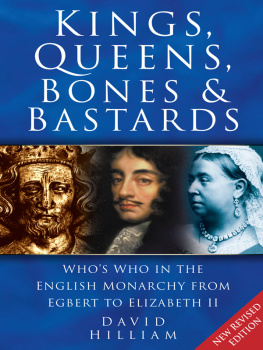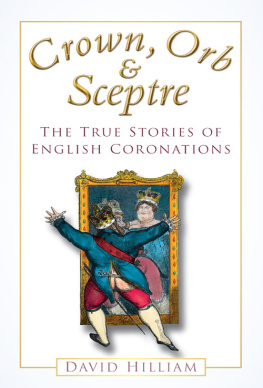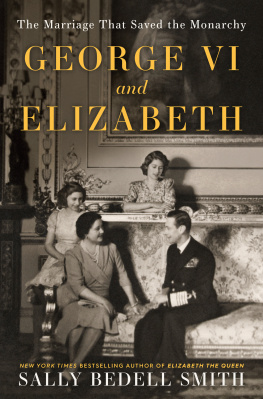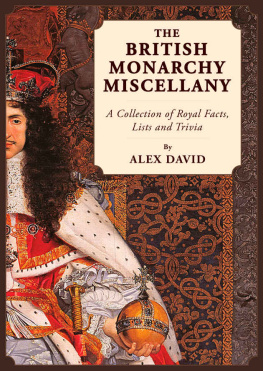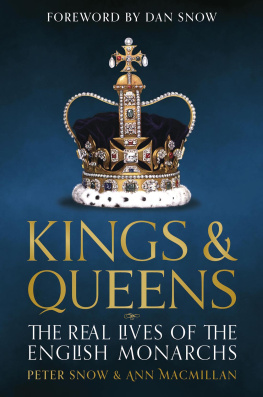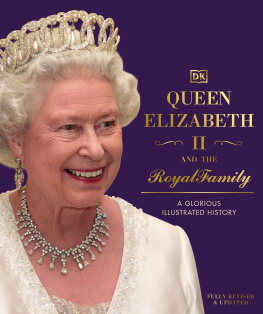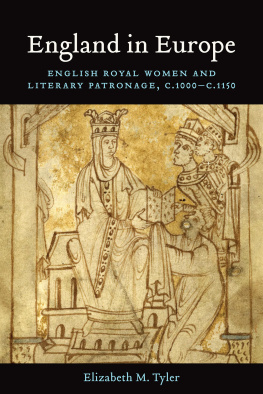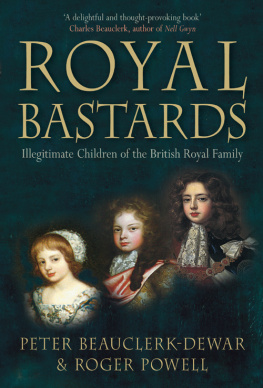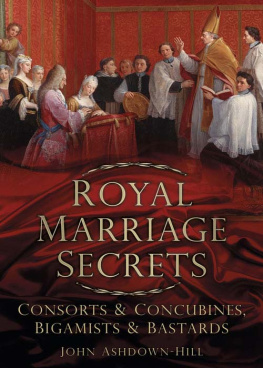PREFACE

This is an account of all the reigning kings and queens of England, including the Protectors, Oliver Cromwell and his son Richard, from Saxon times to the present day. Many history books begin with the reign of William the Conqueror, but this chronicle starts with the Saxon King Egbert, who reigned from AD 802 to 839 and is considered to be the first King of the English (Rex Anglorum). Indeed, although some of the details about these early kings are difficult to verify, even so the line of the English monarchy can be traced back with some certainty over more than 1,200 years to King Egbert (see Appendix, pp. 23941).
The famous and not so famous strengths and successes of each of these monarchs are recounted, as well as their flaws and indiscretions, most of which are far more well known than any of their achievements. It picks over skeletons that have already been displayed for all the world to see, as well as unearthing a few that had been stashed at the back of the royal closet.
Also included is a chapter dedicated to queens and consorts, who are usually completely ignored unless they happen to have been beheaded, or have met with some other unseemly demise. The collection of short biographies shows that they deserve much more attention, for they were often remarkable personalities in their own right.
Bones and burial places hold a curious if macabre fascination. They remind us that even the greatest monarch will eventually crumble to dust and lose his power for ever. Here is an account of what has happened to the mortal remains of the men and women who once shaped the course of English history. Their bones have been venerated, lost, broken up, stolen, even boiled and a fair few flung into rivers and bogs. Fate has not always been kind to them.
Fate was also usually unkind, if not downright unpleasant, to the not so proper companions and offspring of kings. Most kings have had mistresses. And most mistresses have produced bastards. The extra-marital exploits of English kings (and some queens) provide an astonishing sub-plot to the more predictable history of battles and torture and death. Very few of our kings have been faithful to their wives; many have had illegitimate children; some have been homosexual; some have been almost compulsively promiscuous. One took a vow of chastity. In the final chapter here at least some of the facts are revealed.
THE DISTANT PAST: ROMANS TO SAXONS

JUST AFTER THE ROMANS LEFT BRITAIN
The history of Britain immediately after the Romans departed is rather shadowy and confusing. When the last Roman ship left these shores about AD 410 there was an awkward power-vacuum. Total chaos prevailed, and various petty chieftains squabbled among themselves for tiny kingdoms. About forty years later one of these rulers, Vortigern, was so desperate to beat off some northern tribesmen who were troubling him that he imported allies from the continent to help. This was the beginning, for not only did they come but they stayed boatload after boatload of eager immigrants: Angles, Saxons, Jutes, Frisians, Franks. The Anglo-Saxon invasion had begun.
The native Britons, or Celts, were pushed further and further into the fringes of the British Isles into Cornwall, Wales, Scotland. Meanwhile there was a frantic free-for-all as the marauding Saxons seized whatever bits of land they could. Naturally, there was opposition from the Celts, and the almost legendary King Arthur was one of those who led them in trying to beat off the advancing Saxons. However, nothing could stop them arriving and settling.
After a century or so, in about AD 550, there were probably as many as a thousand little Saxon kingdoms, some only a few square miles in area. Theres very little to see nowadays as a reminder of those years, but we do have some clues about the local chieftains of that time in the place-names which still survive.
INGS BEFORE KINGS
Look on a map of England and see what a large number of towns and villages have names ending in ING, or INGHAM, or INGTON. The word ingas meant family or followers, so a chiefs name (say, Tota, Wocca, Haefer, or Padda) would be perpetuated in the name of the spot where his boat landed or where he carved out his little kingdom, and this would be followed by ING to show that Totas family or Woccas followers had settled there with him. Tooting, Woking, Havering and Paddington are typical examples.
A ham meant home or homestead, and a tun was enclosure and later came to mean village or town. So a village with a name such as Washington would suggest that it was the town where Wassas people live. Old Wassa would have been amazed if he had known how world famous his name would become many centuries later!
Gradually, these tiny settlements grouped into larger units and eventually, in the sixth century, seven major Anglo-Saxon kingdoms emerged. And then, in the year 825, these seven kingdoms at last became united under the dominant King Egbert of Wessex, who is therefore regarded as the very first king of a more or less united England. But first, lets look at those seven Saxon kingdoms.
THE SEVEN SAXON KINGDOMS
The seven Saxon kingdoms each lasted for about three hundred years, until finally King Egbert of Wessex was hailed as Bretwalda or sole ruler of Britain round about the year AD 825. For this reason, Egbert is generally recognised as the first English king, and it is possible to trace a line of descent from him right down to our present Queen Elizabeth II. The seven Saxon kingdoms were: Kent, East Anglia, Essex, Sussex, Mercia, Northumberland and Wessex. The sex part of these names is simply a shortened form of Saxon, so that Essex means East Saxons, Sussex means South Saxons, and Wessex, of course, means West Saxons.

